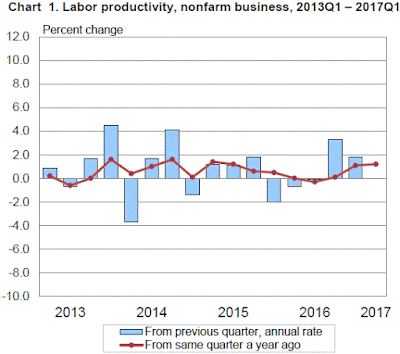Consumer Sentiment: Final Result for June 2017
Predicted: 94.5
Actual: 95.1
- Change from Last Month: -2.06%
- Change from 12 Months Ago: +1.711%
=========
From today's report:
"...Although consumer confidence slipped to its lowest level since Trump was elected, the overall level still remains quite favorable. The average level of the Sentiment Index during the first half of 2017 was 96.8, the best half-year average since the second half of 2000, and the partisan gap between Democrats and Republicans stood at 39 Index-points in June, nearly identical to the 38 point gap in February. The partisan divide still meant that June's Sentiment Index of 95.1 was nearly equal to both the average (95.7) between the optimism of Republicans and the pessimism of Democrats and the value for Independents (94.6). Surprisingly, the optimism among Republicans and Independents has largely resisted declines in the past several months despite the decreased likelihood that Trump's agenda will be passed in 2017. The most important policies to consumers are those that directly or indirectly affect their jobs, incomes, or their financial security. Fortunately, increasing uncertainty about future prospects for the economy has thus far been offset by the resurgent strength in the personal financial situation of consumers. The combination of continuing improvements in personal finances and increasing concerns about the economic outlook is typical around cyclical peaks. Nonetheless, the data provide no indication of an imminent downturn nor do the data provide any indication of a resurgent boom in spending. Even with a much improved 2nd quarter, personal consumption spending is expected to advance during 2017 by about 2.3%..."
=========
The ICS is derived from the following five survey questions:
- "We are interested in how people are getting along financially these days. Would you say that you (and your family living there) are better off or worse off financially than you were a year ago?"
- "Now looking ahead, do you think that a year from now you (and your family living there) will be better off financially, or worse off, or just about the same as now?"
- "Now turning to business conditions in the country as a whole, do you think that during the next twelve months we'll have good times financially, or bad times, or what?"
- "Looking ahead, which would you say is more likely: that in the country as a whole we'll have continuous good times during the next five years or so, or that we will have periods of widespread unemployment or depression, or what?"
- "About the big things people buy for their homes, such as furniture, a refrigerator, stove, television, and things like that. Generally speaking, do you think now is a good or bad time for people to buy major household items?"
- Click here for more on how the ICS is calculated.
=========
The ICS uses a 1966 baseline, i.e. for 1966, the ICS = 100. So any number that is below the 1966 baseline of 100 means that the folks who were polled recently aren't as optimistic about the U.S. economy as the sample that was polled back in 1966.
The ICS is similar to the Consumer Confidence Index in that they both measure consumer attitudes and offer valuable insight into consumer spending.
=========
The "predicted" figure is what economists were expecting, while the "actual" is the true or real figure.
=========
Last month's final ICS reading was 97.1.
Labels: consumer_sentiment, soft_data
|
--> www.FedPrimeRate.com Privacy Policy <--
CLICK HERE to JUMP to the TOP of THIS PAGE > SITEMAP < |










